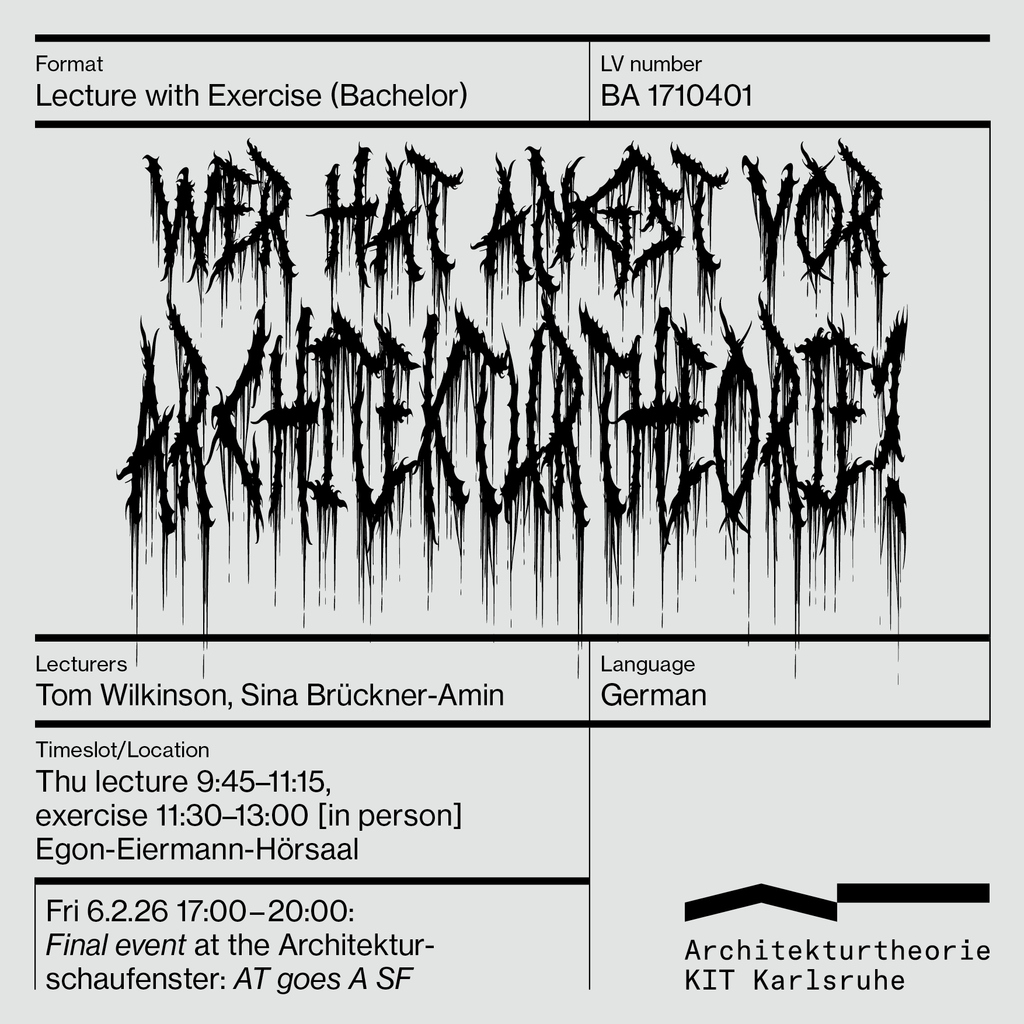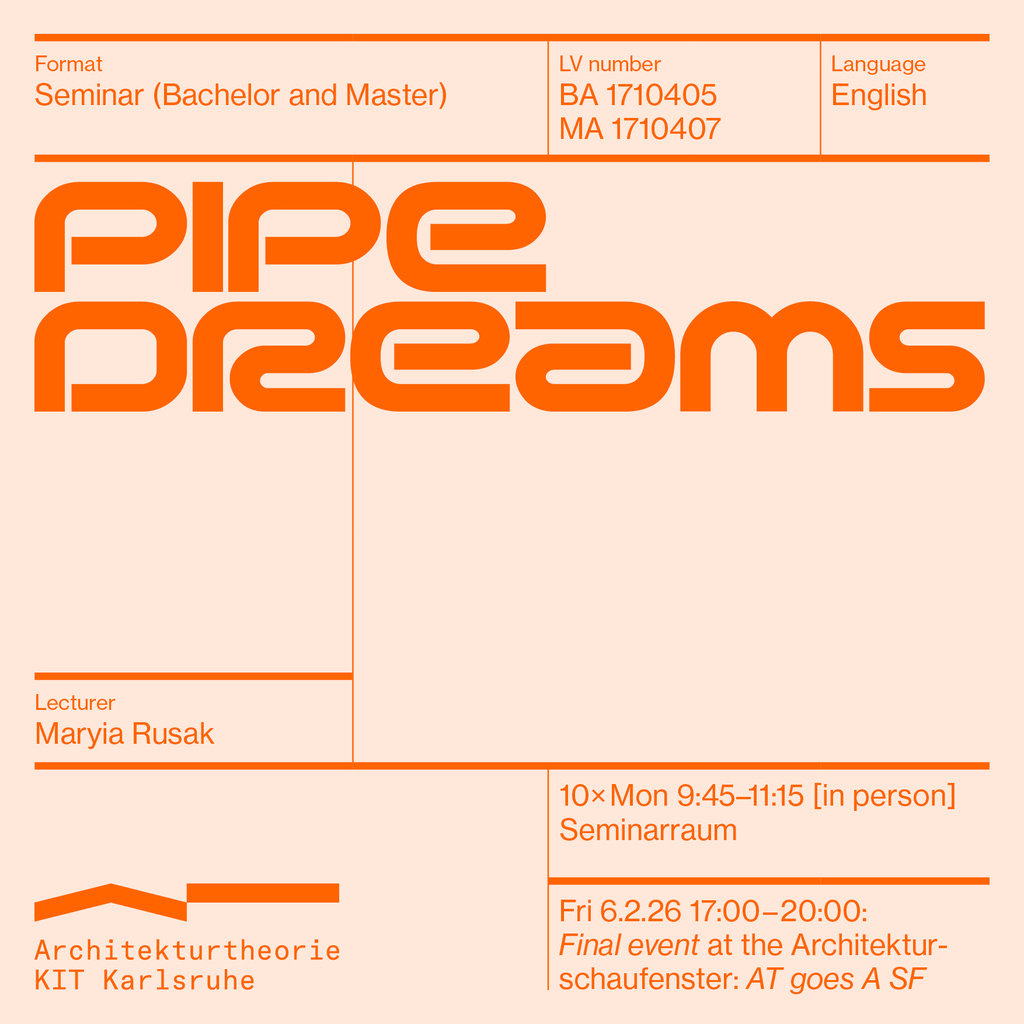Architecture Theory
The processes that shape large-scale built environments require critical analysis. Read through their social impact, bureaucratic and (proto-)digital design processes are understood in a multi-layered and intersectional way. This includes the critical examination of technophilic rhetoric of efficiency, rationalization, precision or function as well as the widening of actor circles or the consideration of consequences of architectural action. The urgent questions of our discipline concerning sustainability (also beyond technicist belief in progress) or diversity (as a real change of perspective, scientifically as well as in practice) are in the foreground. The questions that concern us are therefore the following: who produces which architectures with what (social, political or aesthetic) intention? At whose expense are they produced? Who and what is included or excluded? Which societal images are constructed, and what architectures are projected by societies? In teaching and research, we deepen selected questions methodologically and thematically, always closely linked to reading and writing practices through iterative text production and by approaching multi-perspective bibliographies and formats. Architectures, or better, spatial practices, shape environments in the midst of communities and societies. The responsibility this entails makes informed critical historical and theoretical engagement urgent.
Prof. Dr. Anna-Maria Meister, 2023

What kind of practice is exhibiting architecture? Since 1970s, architecture has increasingly moved into galleries: with models, sketches and plans, architecture began to populate exhibits and biennials, museums and shows. Some of the biggest shifts in architecture discourse have started in and through an exhibition: where people meet, show and talk about architecture, things can be transformed on all scales. But in a discipline where you rarely exhibit the “real thing” - a building or space in 1:1 scale - what is it really that we get to see, show, or experience? Is a model able to represent a space? What about the space that surrounds the exhibits? How are architecture narratives constructed, and what material is used? Whether or not architecture has become “art” (an old discussion), questions of scale, media, and translation are the core of architecture’s exhibitionism. We have invited makers and thinkers - curators, exhibition architects, historians of exhibitions or institution makers - to tell us about their architecture practice through and with exhibitions.
Karlsruher Architekturvorträge
Am 6. November präsentiert Sina Brückner-Amin ihre Forschung zu bürokratischen Planungsökologien der 1950er Jahre in Kalifornien auf der Tagung "Architecture and the Power of Bureaucracy" in Wien. Die Tagung, gemeinsam organisiert durch das Institute of Art History der Czech Academy of Sciences und der Österreichischen Akademie der Wissenschaften, ist Teil des FWF Projekts "Invisible Agents".
Mehr
Architecture is a societal practice: the creation of spaces for others. So why theory? The built environment is a discourse, with statements already standing, critiques being formulated - and like any discourse, it is in constant flux. Hence, whatever architects contribute is always already part of a longer negotiation, and that is why it is important to know what position to take, who one quotes (consciously or unconsciously), what one wants to question, what to stand up for. This includes critical engagement with technophilic rhetorics of efficiency, rationalization, precision, or function, as well as expanding circles of actors or considering the consequences of architectural action. The pressing questions of our discipline about intersectional sustainability beyond the technicist belief in progress or diversification as a real change of perspective are foregrounded. The questions that preoccupy us are therefore: who produces which architectures with what (social, political or aesthetic) intention? At whose expense are they produced? Who and what is included or excluded? What images of society are constructed by them? Different positions will be illuminated in order to ask better and better questions.

The theory and historiography of modern architecture, long focused on the global north, is beginning to be decentred. But one global south nation has always held a prominent role in this story, despite its supposedly peripheral status: Brazil. In this seminar, we will discuss the use of the nation as an epistemological category, models of relative development in architectural history, and the theoretical contributions that have developed out of Brazil’s very particular conditions: vast in scale and disparity, and shaped by colonialism, dictatorship, immigration and slavery.

This seminar will explore architectural elements such as façades, balconies, windows, and ground floors, viewing them not only as functional components but also as cultural, social, and political symbols. We will analyze how these elements acquire new meanings over time, reflecting local identities, economic conditions, and broader historical shifts.
The case study of Georgia is particularly compelling, as the collapse of the Soviet Union sparked a radical transformation of its built environment. The privatization of housing allowed residents to modify standardized housing blocks, leading to self-made alterations that continue to shape urban identity. By situating Georgia’s example within a broader architectural discourse, the seminar will illustrate how seemingly ordinary details can embody dynamic processes of change and serve as living archives of collective experience.

While we often think of space as something abstract, it is shaped by a range of infrastructural systems. The seminar will investigate how existing infrastructural networks—roads, railways, electricity grids, oil pipelines, internet cables and waste systems—provide a concrete physical form to the abstract political idea of a united Europe. The seminar is particularly interested in the physical materiality of mundane infrastructural objects and their generative (and often violent) spatial effects.
During the semester, we will read key texts on the politics of infrastructure and investigate political imaginaries of selected systems. Karlsruhe, an envisioned European oil and data hub in the 1970s, will provide a helpful departure point. We will map the spatial impact of selected infrastructures and envision alternative futures more responsive to the contemporary climate emergency.

On 11 September 2025, Hannah Knoop will present her research on the standardization of architecture in emergencies at the 12th International Congress of AISU in Palermo. Under the title “The Crossroad City”, the conference explores the many meanings of the city as a site of exchange, migration, and cultural intersections. In the session “Interior Spaces of Migration: Dwelling, Displacement, and Identity”, organized by Min Kyung Lee (Bryn Mawr College) and Robin Schuldenfrei (The Courtauld Institute), she will present her paper “Standardized Care and the Interior of Emergency: Migration, Domesticity, and Spatial Adaptation”.
Mehr
On August 20, 2025, Teresa Fankhänel will speak at the AA Visiting School Symposium: Traces in Formation at Zurich University of the Arts. The symposium Traces In Formation examines how traces can be used as material and as a concept in curatorial practice to make hidden structures, power relations and social systems visible. Artists, architects, curators, theorists and activists will come together to understand exhibitions as spaces of disclosure and counter-investigation. The event is part of the Building Information series, which has been organizing international exhibitions, workshops and discussions on information infrastructures since 2022.
Mehr
MA and BA students! Need help figuring out your essays or final projects? Come by our THEORY CLINIC, July 10, from 1 - 4 pm, in room 254, and we will help you get back into the flow of things!
Four times per semester we offer our "theory clinic": stop by without an appointment to discuss your design process and where it hurts. We offer references, comments and feedback for the neuralgic points in open table critiques - completely unbiased. Walk-ins are welcome!

On July 3 and 4, 2025, Sina Brückner-Amin will take part in the workshop “The Report: History and Theory of a Procedural Text Form” at the University of Bremen. The workshop works at the interface between the history of science and the history of bureaucracy. Paper drafts will be discussed and the conception of an interdisciplinary joint book will be worked on. During the workshop, Sina Brückner-Amin will present her research on the “Master Plan for Higher Education” in California in the 1950s.
On the occasion of its 25th anniversary, the Architektur Galerie Berlin invites you to a special exhibition that deals with the future of exhibiting architecture: How is the presentation of architecture changing in the age of digital communication? What role do analog formats play and how can new media possibilities be meaningfully integrated? In collaboration with curators, including Teresa Fankhänel, and architects, the gallery takes a look ahead: the focus is on new forms of communication, changing viewing habits and the question of what exhibitions could look like in the future - from mobile formats to greater integration of public space. The exhibition is part of the anniversary program and invites visitors to think, discuss and discover.
The opening with an introductory speech by Teresa Fankhänel is on July 10, 7 pm at the Architektur Galerie Berlin

Newly published, also in Open Access: In his article “Siegfried Kracauer, Architectural Employee”, Tom Wilkinson examines how Kracauer's early professional experience as an architect shaped his later works of cultural criticism. The focus is on the year 1930, when Kracauer took a materialistic look at the precarious realities of life in the urban middle class with The Employee. The thesis is that it was not only his training, but also his frustrating practice as an architect that prepared the ground for his political thinking. Against the backdrop of today's labor struggles of young architects, Kracauer's analysis is once again gaining topicality.
Mehr
